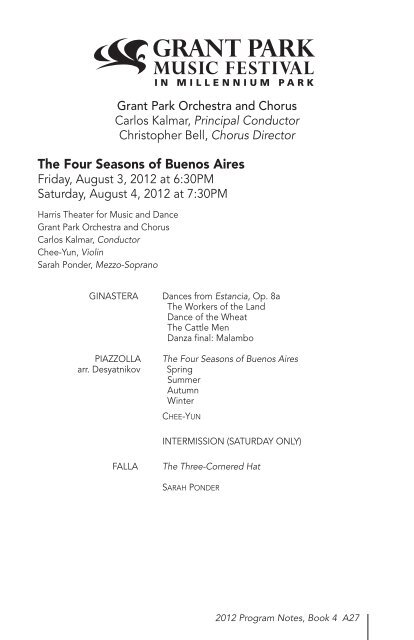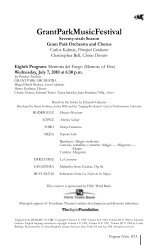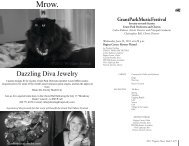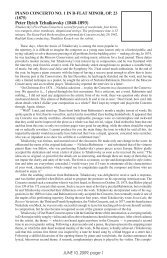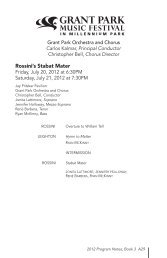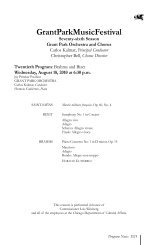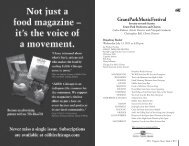The Four Seasons of Buenos Aires - The Grant Park Music Festival
The Four Seasons of Buenos Aires - The Grant Park Music Festival
The Four Seasons of Buenos Aires - The Grant Park Music Festival
Create successful ePaper yourself
Turn your PDF publications into a flip-book with our unique Google optimized e-Paper software.
<strong>Grant</strong> <strong>Park</strong> Orchestra and Chorus<br />
Carlos Kalmar, Principal Conductor<br />
Christopher Bell, Chorus Director<br />
<strong>The</strong> <strong>Four</strong> <strong>Seasons</strong> <strong>of</strong> <strong>Buenos</strong> <strong>Aires</strong><br />
Friday, August 3, 2012 at 6:30PM<br />
Saturday, August 4, 2012 at 7:30PM<br />
Harris <strong>The</strong>ater for <strong>Music</strong> and Dance<br />
<strong>Grant</strong> <strong>Park</strong> Orchestra and Chorus<br />
Carlos Kalmar, Conductor<br />
Chee-Yun, Violin<br />
Sarah Ponder, Mezzo-Soprano<br />
GINASTERA<br />
PIAZZOLLA<br />
arr. Desyatnikov<br />
Dances from Estancia, Op. 8a<br />
<strong>The</strong> Workers <strong>of</strong> the Land<br />
Dance <strong>of</strong> the Wheat<br />
<strong>The</strong> Cattle Men<br />
Danza final: Malambo<br />
<strong>The</strong> <strong>Four</strong> <strong>Seasons</strong> <strong>of</strong> <strong>Buenos</strong> <strong>Aires</strong><br />
Spring<br />
Summer<br />
Autumn<br />
Winter<br />
Chee-Yun<br />
INTERMISSION (SATURDAY ONLY)<br />
FALLA<br />
<strong>The</strong> Three-Cornered Hat<br />
sarah Ponder<br />
2012 Program Notes, Book 4 A27
carlos kalmar’s biography can be found on page 10.<br />
Friday, August 3 and Saturday, August 4, 2012<br />
Violinist Chee-Yun, born in Seoul, Korea, was the winner <strong>of</strong><br />
the 1989 Young Concert Artists International Auditions and a<br />
1990 Avery Fisher Career <strong>Grant</strong>. She performs regularly with<br />
the world’s foremost orchestras, including the Philadelphia<br />
Orchestra, Hong Kong Philharmonic, St. Petersburg Camerata,<br />
London Philharmonic, NHK Symphony (Japan), Haifa Symphony,<br />
MDR Radio Leipzig and the Toronto, Pittsburgh, Houston,<br />
Seattle, Pittsburgh, Atlanta and National symphony orchestras.<br />
Her career highlights include appearances at Kennedy Center’s<br />
“Salute to Slava” gala honoring Mstislav Rostropovich, the<br />
Mostly Mozart <strong>Festival</strong>’s tour to Japan, a performance with Michael Tilson Thomas in<br />
the inaugural season <strong>of</strong> Carnegie Hall’s Zankel Hall, and the United States premiere<br />
<strong>of</strong> Penderecki’s Violin Sonata No. 2 with pianist Barry Douglas. Firmly committed to<br />
chamber music, Chee-Yun has toured with <strong>Music</strong> from Marlboro and appears frequently<br />
with the Spoleto USA, Ravinia, Aspen, Bravo! Vail Valley, La Jolla, Caramoor, Green<br />
<strong>Music</strong>, Santa Fe and Bridgewater festivals in the United States, as well as the Great<br />
Mountains <strong>Music</strong> <strong>Festival</strong> in South Korea, Clandeboye <strong>Festival</strong> in Northern Ireland,<br />
Opera <strong>The</strong>atre and <strong>Music</strong> <strong>Festival</strong> in Lucca, Italy, Colmar <strong>Festival</strong> in France, Beethoven<br />
and Penderecki festivals in Poland and Kirishima <strong>Festival</strong> in Japan. Her recordings<br />
appear on the Naxos, Denon and Satirino labels. In 2007, she was appointed Artistin-Residence<br />
and Pr<strong>of</strong>essor <strong>of</strong> Violin at Southern Methodist University in Dallas.<br />
Chee-Yun plays the Stradivarius “Ex-Strauss” violin (Cremona, 1708), which is on loan<br />
through the generous efforts <strong>of</strong> the Samsung Foundation <strong>of</strong> Culture <strong>of</strong> Korea and the<br />
Stradivari Society <strong>of</strong> Chicago.<br />
Mezzo-soprano Sarah Ponder frequently performs as both<br />
a soloist and ensemble singer with Chicago’s finest musical<br />
organizations. Favorite recent performances include a recital<br />
with the <strong>Music</strong>ians Club <strong>of</strong> Women “Award Winners in Concert”<br />
Series, the role <strong>of</strong> Ino in Handel’s Semele, and solo appearances<br />
with Maestro Riccardo Muti as part <strong>of</strong> her continued work as a<br />
Teaching Artist with the Chicago Symphony Orchestra’s outreach<br />
programs. In addition to her performing and outreach work, Sarah<br />
also maintains a large private studio.<br />
Dances from Estancia, Op. 8a (1941)<br />
Alberto Ginastera (1916-1983)<br />
Estancia is scored for piccolo, flute, two oboes, two clarinets,<br />
two bassoons, four horns, two trumpets, timpani, percussion,<br />
piano and strings. <strong>The</strong> performance time is 13 minutes. <strong>The</strong><br />
<strong>Grant</strong> <strong>Park</strong> Orchestra first performed these Dances on July 20,<br />
1960, with Milton Katims conducting.<br />
<strong>The</strong> career <strong>of</strong> Alberto Ginastera, Argentina’s most famous<br />
and widely performed composer, was divided between composition and education,<br />
and in this latter capacity he held posts at leading conservatories and universities in<br />
Argentina and at Dartmouth College in New Hampshire. His musical works, many<br />
written on American commissions, include three operas, two ballets, six concertos,<br />
eleven film scores, eight orchestral works, various vocal and choral compositions, and<br />
A28 2012 Program Notes, Book 4
Friday, August 3 and Saturday, August 4, 2012<br />
much music for chamber ensembles and piano. For his contributions to music, he was<br />
honored with many awards, including memberships in the American Academy <strong>of</strong> Arts<br />
and Sciences and the American Academy <strong>of</strong> Arts and Letters.<br />
Lincoln Kirstein, director <strong>of</strong> the American Ballet Caravan, became familiar with<br />
Ginastera’s first ballet, Panambi, during the company’s tour <strong>of</strong> South America on 1941.<br />
Recognizing the young composer’s genius, Kirstein commissioned from Ginastera<br />
Estancia, a stage work for the Ballet Caravan with a scenario based on Argentine<br />
country life. Though the company was disbanded the following year before it had<br />
performed the new work, a suite <strong>of</strong> dances from the score was given on May 12, 1943<br />
at <strong>Buenos</strong> <strong>Aires</strong>’ Teatro Colón which confirmed Ginastera’s position as a leading figure<br />
in Argentine musical life. (<strong>The</strong> full ballet was not staged until 1952, at the Colón.) In<br />
extracting the suite from Estancia, Ginastera omitted the songs for baritone based<br />
on texts from the great epic poem <strong>of</strong> the “gauchesco” literature, Martin Fierro, and<br />
several pastoral scenes. Except for the gentle second dance, Danza del trigo (“Dance<br />
<strong>of</strong> the Wheat”), the symphonic suite, comprising Los trabajadores agricolas (“<strong>The</strong><br />
Workers <strong>of</strong> the Land”), Los peones de hacienda (“<strong>The</strong> Cattle Men”) and Danza final:<br />
Malambo (“Final Dance: Malambo”), is brilliant and driving, largely built on short,<br />
recurring rhythmic and melodic patterns that accumulate enormous energy.<br />
<strong>The</strong> preface to the score notes, “<strong>The</strong> deep and bare beauty <strong>of</strong> the land, its richness<br />
and natural strength, constitutes the basis <strong>of</strong> Argentine life. This ballet presents various<br />
daily aspects <strong>of</strong> the activities <strong>of</strong> an ‘estancia’ (Argentine ranch), from dawn to dusk,<br />
with a symbolic sense <strong>of</strong> continuity. <strong>The</strong> plot <strong>of</strong> the ballet shows a country girl who at<br />
first despises the man <strong>of</strong> the city. She finally admires him when he proves that he can<br />
perform the most rough and difficult tasks <strong>of</strong> the country.”<br />
<strong>The</strong> <strong>Four</strong> <strong>Seasons</strong> <strong>of</strong> <strong>Buenos</strong> <strong>Aires</strong> (1968)<br />
Astor Piazzolla (1921-1992)<br />
Piazzolla’s <strong>Four</strong> <strong>Seasons</strong> <strong>of</strong> <strong>Buenos</strong> <strong>Aires</strong>, as arranged by the St.<br />
Petersburg composer Leonid Desyatnikov, is scored for strings<br />
and solo violin. <strong>The</strong> performance time is 25 minutes. This is the<br />
first performance <strong>of</strong> this work by the <strong>Grant</strong> <strong>Park</strong> Orchestra.<br />
<strong>The</strong> greatest master <strong>of</strong> the modern tango was Astor Piazzolla,<br />
born in Mar Del Plata, Argentina, a resort town south <strong>of</strong> <strong>Buenos</strong><br />
<strong>Aires</strong>, in 1921 and raised in New York City, where he lived with his father from 1924<br />
to 1937. Before Astor was ten years old, his musical talents had been discovered by<br />
Carlos Gardel, then the most famous <strong>of</strong> all performers and composers <strong>of</strong> tangos and<br />
a cultural hero in Argentina. At Gardel’s urging, the young Astor returned to <strong>Buenos</strong><br />
<strong>Aires</strong> in 1937 and joined the popular tango orchestra <strong>of</strong> Anibal Troilo as arranger and<br />
bandoneón player. Piazzolla studied classical composition with Alberto Ginastera in<br />
<strong>Buenos</strong> <strong>Aires</strong>, and in 1954, he wrote a symphony for the <strong>Buenos</strong> <strong>Aires</strong> Philharmonic<br />
that earned him a scholarship to study in Paris with Nadia Boulanger. When Piazzolla<br />
returned to <strong>Buenos</strong> <strong>Aires</strong> in 1956, he founded his own performing group, and began<br />
to create a modern style for the tango that combined elements <strong>of</strong> traditional tango,<br />
Argentinean folk music and contemporary classical, jazz and popular techniques into a<br />
“Nuevo Tango” that was as suitable for the concert hall as for the dance floor. Piazzolla<br />
toured widely, recorded frequently and composed incessantly until he suffered a<br />
stroke in Paris in August 1990. He died in <strong>Buenos</strong> <strong>Aires</strong> on July 5, 1992.<br />
Piazzolla realized his electrifying blend <strong>of</strong> the fire and passion <strong>of</strong> the traditional<br />
tango with the vast expressive resources <strong>of</strong> modern harmony, texture and sonority<br />
in some 750 widely varied works that explore the genre’s remarkable expressive<br />
2012 Program Notes, Book 4 A29
Friday, August 3 and Saturday, August 4, 2012<br />
range, from violent to sensual, from witty to melancholy, from intimate to theatrical.<br />
Among his most ambitious concert works is Las Quatro Estaciones Porteñas (“<strong>The</strong><br />
<strong>Four</strong> <strong>Seasons</strong>”), published originally for piano solo in 1968 and later arranged for his<br />
own ensemble (he <strong>of</strong>ten used one <strong>of</strong> the movements to open his concerts) and for<br />
strings and piano. <strong>The</strong> four movements, beginning with Spring, are not specifically<br />
pictorial, as are Vivaldi’s well-known precedents, but are instead general evocations <strong>of</strong><br />
the changing seasons in Piazzolla’s native Argentina.<br />
<strong>The</strong> Three-Cornered Hat (1917, 1919)<br />
Manuel de Falla (1876-1946)<br />
<strong>The</strong> Three-Cornered Hat is scored for pairs <strong>of</strong> woodwinds plus<br />
piccolo and English horn, three horns, three trumpets, three<br />
trombones, tuba, timpani, percussion, harp, piano, celesta and<br />
strings. <strong>The</strong> performance time is 30 minutes. <strong>The</strong> <strong>Grant</strong> <strong>Park</strong><br />
Orchestra first performed selections from the ballet on July 9,<br />
1948, with Alfredo Antonini conducting.<br />
<strong>The</strong> dazzling Parisian success <strong>of</strong> Sergei Diaghilev’s Ballet Russe that began in 1909<br />
came to an abrupt halt when the Guns <strong>of</strong> August tore across Belgium and France to<br />
begin World War I in 1914. Diaghilev, Leonide Massine and some <strong>of</strong> the company took<br />
refuge in Switzerland and Spain, while Nijinsky and others fled to America. Diaghilev<br />
arranged a season in Spain for 1917, and, always on the prowl for new talent, he took<br />
the opportunity to look up a musician Stravinsky had met in Paris in 1910. Stravinsky<br />
described his Spanish colleague as “even smaller than myself, and as modest and<br />
withdrawn as an oyster... unpityingly religious, and the shyest man I have ever met.”<br />
His name was Manuel de Falla.<br />
Falla, a meticulous worker who composed slowly, had completed only a small<br />
number <strong>of</strong> works by 1917 — most notably Nights in the Gardens <strong>of</strong> Spain, the opera<br />
La Vida Breve (“<strong>The</strong> Brief Life”) and the ballet El Amor Brujo (“Lover, the Magician”) —<br />
and he was little known outside his homeland. When Diaghilev and Massine introduced<br />
themselves to him in Barcelona, he took them to see a one-act farce set in the early<br />
19th century about the attempted seduction <strong>of</strong> a miller’s wife by the local governor<br />
for which he had provided the music, El corregidor y la molinera (“<strong>The</strong> Corregidor and<br />
the Miller’s Wife”). <strong>The</strong> script for this “pantomime” was by Gregorio Martinez Sierra,<br />
who based it on a short novel by Pedro de Alarcon published in 1874 as El sombrero<br />
de tres picos. Alarcon was said to have heard the story in turn from an old goatherd<br />
who hired himself out as an entertainer for local weddings and feasts. Of Falla’s score,<br />
Massine wrote that it “seemed to us very exciting, and its blend <strong>of</strong> violence and<br />
passion was similar to much <strong>of</strong> the music <strong>of</strong> the local folk-dances. Both Diaghilev and I<br />
felt that the story and the music <strong>of</strong>fered us the potentials <strong>of</strong> a full-length ballet.” Falla<br />
accepted Diaghilev’s proposal to revise and extend his score for production when the<br />
war was over, but gave the provision that he be allowed enough time to study Spanish<br />
folk music and dance styles to assure the correct atmosphere for the finished work. It<br />
was not until World War I ended that the production <strong>of</strong> <strong>The</strong> Three-Cornered Hat could<br />
be staged as part <strong>of</strong> the 1919 London season <strong>of</strong> the Ballet Russe.<br />
<strong>The</strong> racy story <strong>of</strong> the ballet has its roots in the folk traditions <strong>of</strong> Spain. <strong>The</strong> curtain<br />
rises on the sunny esplanade beside a mill. <strong>The</strong> miller and his pretty wife are busy<br />
about their chores. A stately procession enters carrying the elderly Corregidor (the<br />
local magistrate) and his wife. <strong>The</strong> Corregidor is attracted to the miller’s wife, and slips<br />
back after his retinue has left to make his advances. <strong>The</strong> wife tells her husband to hide<br />
and watch her spurn the old man’s attempts at love. She dances a brilliant fandango<br />
and further tantalizes him with a bunch <strong>of</strong> grapes. He chases her, trips, and becomes<br />
2012 Program Notes, Book 4 A31
Friday, August 3 and Saturday, August 4, 2012<br />
aware <strong>of</strong> the teasing intrigue between husband and wife. <strong>The</strong> Corregidor departs, and<br />
the miller and his wife cheerfully resume the fandango.<br />
Part II <strong>of</strong> the ballet takes place that evening, St. John’s Night. <strong>The</strong> miller and his<br />
wife are joined in celebration by their neighbors, and together dance the popular<br />
seguidillas. <strong>The</strong> miller performs a virile farruca. <strong>The</strong> festivities are interrupted by the<br />
local constabulary, who have come to arrest the miller on a charge trumped up by the<br />
Corregidor to get him out <strong>of</strong> the way. <strong>The</strong> Corregidor appears as soon as the miller is<br />
led away, but falls into the millstream as he is pursuing the girl. She runs <strong>of</strong>f in search<br />
<strong>of</strong> her husband, while the Corregidor removes his sodden clothes, including his threecornered<br />
hat — the symbol <strong>of</strong> his <strong>of</strong>fice — hangs them on a chair outside the mill, and<br />
jumps into the absent girl’s bed to ward <strong>of</strong>f a chill. Meanwhile, the miller has escaped<br />
from his captors to return home, sees the Corregidor’s discarded clothes and believes<br />
himself betrayed by his wife. Vowing to get even, he exchanges his garments for those<br />
<strong>of</strong> the <strong>of</strong>ficial, scribbles on the wall “<strong>The</strong> wife <strong>of</strong> the Corregidor is also very pretty,”<br />
and runs <strong>of</strong>f in search <strong>of</strong> his conquest. <strong>The</strong> Corregidor emerges from the bedroom to<br />
find only the miller’s clothes. He puts them on just in time for the police, hunting their<br />
escaped prisoner, to arrest him by mistake. <strong>The</strong> miller’s wife returns, followed by the<br />
miller, and the two are happily reconciled in the joyous final dance while the villagers<br />
toss a straw effigy <strong>of</strong> the Corregidor in a blanket.<br />
©2012 Dr. Richard E. Rodda<br />
Introduction<br />
Ole! Ole! Ole! Ole!<br />
ole! Ole! Ole! Ole!<br />
Casadita, Casadita,<br />
Little wife, little wife,<br />
cierra con tranca la puerta!<br />
bolt your door!<br />
Ole! Ole! Ole! Ole!<br />
ole! Ole! Ole! Ole!<br />
Casadita, Casadita,<br />
Little wife, little wife,<br />
cierra con tranca la puerta;<br />
bolt your door;<br />
Que aunque el diablo esté dormido,<br />
the devil may be asleep,<br />
a lo mejor se despierta!<br />
but he awakes when least expected.<br />
Que aunque , etc.<br />
<strong>The</strong> devil, etc.<br />
Ole! Ole! Ole! Ole!<br />
ole! Ole! Ole! Ole!<br />
Dance <strong>of</strong> the Miller’s Wife<br />
Por la noche canta el cuco<br />
Through the night the cuckoo sings<br />
Advirtiendo a los casados<br />
warning husbands<br />
que corran bien los cerrojos<br />
to fix the bolts firmly<br />
que el diablo está desvelado!<br />
for the devil is awake!<br />
Por la noche canta el cuco — Through the night the cuckoo sings —<br />
Cucú! Cucú! Cucú!<br />
Cuckoo! Cuckoo! Cuckoo!<br />
Did the music move you?<br />
If you enjoyed tonight’s concert and want to help keep the<br />
music playing all summer long, you can donate $ 10 to the<br />
<strong>Festival</strong> using your mobile phone.<br />
Text GRANTPARK to 20222* and give the gift <strong>of</strong> music today!<br />
* $ 10.00 will be charged to your mobile phone bill or deducted from your prepaid balance.<br />
Msg & Data rates may apply. Terms: www.hmgf.org/t. Reply STOP to end or HELP for help.<br />
2012 Program Notes, Book 4 A33


